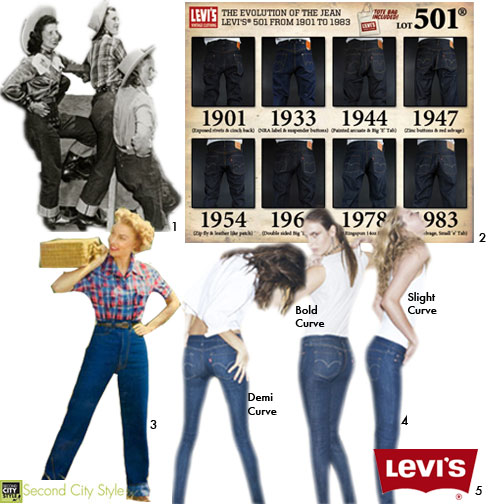
Blue jeans are a wardrobe staple. I’ve been told by boyfriends and my father alike, a single sturdy pair is sufficient for quite a number of years. But what’s the fun in only having one pair? Sure they’re durable, but that quality seems to fade when the number of styles, cuts, colors and brands seems limitless. It’s no wonder denim is a billion dollar industry when, according to PR News, the average American woman owns seven pairs of jeans. While the popular history of blue jeans is predominately American focused, its name and origin actually hails from France. The heavy twill fabric was originally called serge de Nimes, with Nimes being the town where denim was first made. Jeans also has French connections, as Genes is the French name for Genoa, Italy, the first place denim trousers were made. Even one of France’s most popular fashion designer, Yves Saint Laurent, has been quoted as saying: “I have often said that I wish I had invented blue jeans: the most spectacular, the most practical, the most relaxed and nonchalant. They have expression, modesty, sex appeal, simplicity – all I hope for in my clothes.” Yet even with its roots originating from France, blue jeans are decidedly American, thanks in great part to Levi Strauss and his 501s.
American men and women have been wearing blue jeans since the late 1800s, but not as casual fashion, instead they were designed for mine workers out west. The weighty material was ideal for manual laborers because it was so durable. Levi Strauss’s modern blue jeans came to be when tailor, Jacob Davis, approached Strauss with the idea of adding rivets to stress points in the denim pants so that they could last even longer. The first pair of Levi’s 501 Jeans was made in 1890 and has since become the best-selling item of clothing. But still, while cowboys and girls wore the denim trousers, blue jeans worn as a fashion statement wouldn’t become popular until the 1950s when bad boy James Dean would wear a pair in Rebel Without a Cause. When teens and American youths began wearing blue jeans it was more of a sign of rebellion and because of that they were often band from being worn in schools, restaurants and theaters. But soon after, blue jeans’ popularity spread to include people other than beatniks and hippies, and now jeans are worn everywhere for just about every occasion.
It may seem that Levis would be old news when it comes to the blue jeans industry since the market is flooded year after year with designer jeans and other new high-end denim companies. Blue jeans are no longer just blue jeans, they’re dyed any number of colors, stressed and shredded to show various portions of the leg and bedazzled with stones and diamonds alike. But Levi’s is still a contender, in more ways than one, as it seems that other jeans companies look to Levi’s for style and branding. The New York Times reported that Levi Strauss has the most trademark infringement cases within the apparel industry, most of which revolve around the double arc gold stitches on the rear pockets. Levis has sued and won a number of cases against other popular denim companies such as Lucky Brand Jeans, Guess and Polo Ralph Lauren. The demand for Levis is so high that they’re knocked off and sold. There are even web sites that help customers spot a real pair from a fake. There are claims that Levi’s 506s are still made the same as they were in the 1800s and as vintage is king, Levi Strauss is smart to not fix a perfect pair of jeans.
1. Women’s Vintage Levis Jeans
2. Levi’s 501 Jeans History
3. Lady’s Levis, The Original Western Blue Jean
4. Levi’s Curve ID
5. Levi’s Logo
—Bonnie J Brown
Image Layout: Kristine Horton

